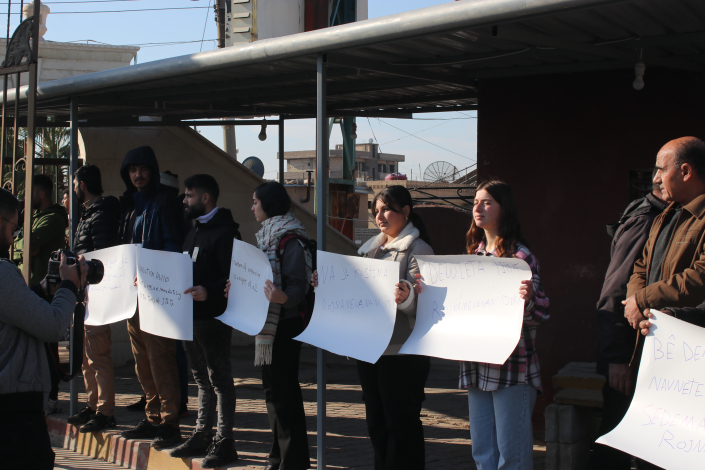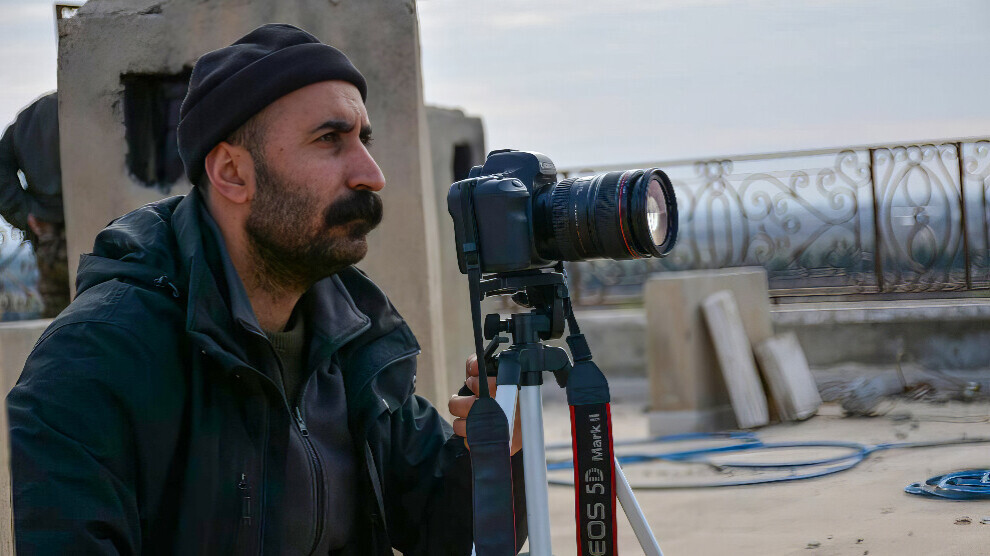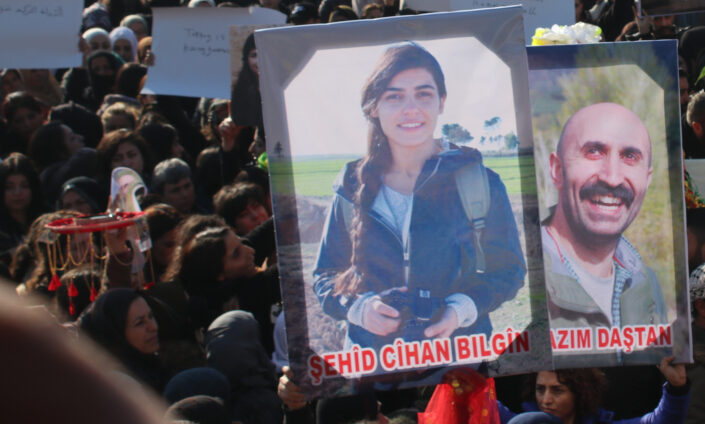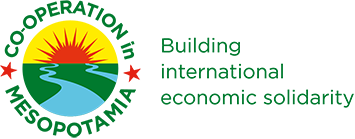
Press freedom under attack
Threats and violence against journalists – particularly those who focus on human rights violations and criminal activity or who report from war-zones – is a global phenomenon. Journalism is widely greeted as a fundamental pillar of democracy, yet every four days a journalist is killed worldwide, according to UNESCO statistics. 85% of journalist killings recorded by UNESCO from 2006 to 2024 were unresolved, with the killer going unpunished. These statistics are reflected in a global trend of deteriorating media freedom. Amongst the most striking examples of this is Turkey.
“Crimes against journalists have an enormous impact on society as a whole, because they prevent people from making informed decisions” – Audrey Azoulay, Director-General of UNESCO
Reporters Without Borders’ (RSF) 2024 World Press Freedom Index ranks Turkey 158th out of 180 countries, describing the situation as “very serious”. In a damming evaluation of the last ten years of Erdogan’s rule, RSF’s Turkey representative commented: “Exploitation of the judicial system and public broadcasting, and the stranglehold on media ownership and regulatory institutions, have jeopardised the right to news and information, without which the rule of law cannot exist.” While numbers of journalists actually being imprisoned are no longer at the levels they were in 2016, Turkish authorities continue to arrest journalists (and their lawyers) who report critically, but permit many to await trial outside of prison. Turkey was the world’s top jailer of journalists in 2016, 2017 and 2018, and has consistently ranked high on the global list since then, coming in at number 10 in 2023. Most journalists arrested face anti-state accusations. Over the past decade, Turkish President Recep Tayyip Erdogan’s establishment of a hyper-presidential system has grievously undermined press freedom and media pluralism. The 2023 elections, won by Erdogan’s AKP (Justice and Development Party), featured the arrests of dozens of Kurdish journalists, extensive online censorship, arbitrary lawsuits against critical media outlets, and naked exploitation of the judicial system generating a culture of impunity. 90% of the national media is under government control.
Turkey’s domestic repression of journalism has been well-documented. What has been less investigated are Erdogan’s efforts to stifle press south of the Turkish border, by targeting those reporting on Turkey’s war and occupation in the region of North and East Syria (NES).
Turkish drone strike kills two journalists
At around 15:20 on December 19th, two Kurdish journalists, Nazim Dashtan and Cihan Bilgin, were killed by a Turkish drone strike on the road between the Tishreen dam and the town of Sarrin, in the southern Kobane countryside. Both had been in Manbij covering the offensive of the Turkish-backed Syrian National Army (SNA), and had subsequently been following the ongoing clashes at the Tishreen Dam and Qaraqozak Bridge since Manbij city was taken from the Syrian Democratic Forces (SDF) by the SNA.

Nazim Dashtan was a Kurdish journalist holding Turkish citizenship. His journalistic work began in 2012 with the Dicle news agency (DIHA) in Turkey. Amongst other things, he covered the mobilizations for Kobane from the Turkish side during ISIS’ siege on the city in 2014. He also was part of the investigation into the murder of Syrian journalist Nazi el Derf, who was shot in the head in 2015 in Antep while working on a documentary about ISIS. Dashtan himself was arrested for his investigations and threatened by the intelligence services. In 2016, he was sent to prison for “belonging to a terrorist organization” – an accusation levelled against many Kurdish journalists critical of President Erdogan – and was cleared of all charges and released after five months. Later that year, he fled Turkey and came to North and East Syria (NES). Alongside many other journalists from the international press, he covered the SDF’s fight against ISIS until its completion in Baghouz. Dashtan was currently employed by Mezopotamya Ajansi, a pro-Kurdish Turkish news agency – and one that is regularly targeted by the Erdogan government’s crackdown on press, subject to office-searchings and employee arrests.

Cihan Bilgin was a Kurdish journalist holding Turkish citizenship. She studied law in Turkey and then began working in press in 2014, following the mobilizations in defence of Kobane in Suruc. She came to NES in 2017 due to the pressure she was under from the Turkish state. As an employee of the Syrian news agency ANHA, her first press assignment in NES was covering the SDF’s campaign against ISIS in Raqqa, before going on to report on both war and civil-related developments in the region, with a particular focus on women and gender-issues. During the Turkish-backed SNA’s attack on Manbij, Bilgin was covering the situation day-by-day. The final interview she conducted was with a commander of the all-female YPJ units on the frontlines.1

Other journalists targeted working in NES
Dashtan and Bilgin are not the first journalists killed in Turkish attacks in NES. RIC has tracked journalist casualties of Turkish strikes since the 2019 M4 Strip invasion.
On 23 August, 2023, Delila Agit, reporter for the all-female station Jin TV, was injured when her car was targeted by a Turkish drone. Agit’s car was struck as she travelled to cover a ceremony commemorating the killing of three civilian political figures who had been targeted in a previous Turkish drone strike. She lost her arm and her driver was killed. On 20 November, 2022, Isam Abdullah, an ANHA correspondent, was killed in a Turkish airstrike on Teqil Beqil, near Derik. On the night of his killing, Abdullah had gone to Teqil Beqil immediately after a Turkish attack there which had killed a civilian worker and caused major damage to critical power facilities, alongside of a group of first-responders. A follow-up airstrike – occurring as Abdullah was reporting the news – killed him and six other civilians. During his final broadcast, Abdullah relayed that Turkish bombardment of Derik’s Kocherat region was ongoing, with drones continuously flying overhead. He had been reporting from the region since 2013. On 20 November, 2022, Mihemed Jerada, who works for the Kurdish channel Sterk TV, was severely wounded and suffered a cerebral hemorrhage from a Turkish airstrike, while conducting a live broadcast outside a hospital in the outskirts of Kobane that Turkey had targeted the day prior. In an interview with Reporters Without Borders, Jerada said he believed the attack was deliberate:
“The Turks want to target Kurdish journalists to cover up the atrocities they are committing in the region. They want to silence the media that are showing the world what they are doing.”
During and in the aftermath of Turkey’s 2019 invasion of Sere Kaniye and Tel Abyad, RIC recorded several instances in which journalists were targeted. On 11 November, 2019, Zozan Berkele – a local Jin TV journalist – was shot by Turkish forces while attempting to cover a joint Turkish-Russian patrol in the east Kobane countryside. Berkele told RIC:
“They fired because they saw we were filming. They struck our car, the car of [local TV station] Ronahi TV and a Ronahi TV camera… I was struck by a bullet. My hand will be in plaster for a month.”
On 11 November, 2019, the 27-year old father-of-two Vedat Erdemci, a Kurdish film-maker and journalist from Turkey, was killed in a Turkish airstrike, as he was filming Turkish warplanes flying over Sere Kaniye. Turkish-backed SNA militiamen then proceeded to send pictures of his decapitated body to his mother. On 13 November, 2019, a Turkish airstrike on a civilian convoy on its way to Sere Kaniye killed eleven people – including two journalists – and wounded scores more. The two journalists were 19-year-old Saad Ahmed, a reporter for ANHA and native of Bab al-Khair village near Tel Tamr, who was killed instantly and Mohamed Resho, a journalist for the Yezidi station Cira TV, who died of his injuries the next day. Several other journalists travelling with the convoy sustained injuries: Dilsoz Youssef (North Press Agency), Ersin Chaksu (ANF), Emre Yunis (Sterk TV), Mehmet Ekici (ANHA), Huner Ehmed (Rudaw), Birjan Yildiz, Rojbin Ekin and Abdreshid Mihemed (all freelancers). On November 9, Fadel Hammad, a Syrian reporter for the al-Akhbariya TV channel, was hit in the foot by Turkish shelling near Tel Tamr.
Information gathering obstructed in SNA-held areas
Inside NES, reporters covering Turkish atrocities in the region are vulnerable to attack. In the Turkish-occupied regions of Syria meanwhile, journalists and researchers attempting to gather information and report on rights violations committed by Turkey and the Turkish-backed SNA face significant obstacles. Turkish restrictions on media there suffocate the possibilities for independent journalism, while most civilians are too fearful of SNA reprisal to dare to participate in media activism or even record evidence of and report the crimes they witness and experience. Those seeking to expose SNA and Turkish crimes face harassment, imprisonment, or killing for their work – discouraging most from even considering such activities. Following the SNA’s assassination of media activist Muhammad Abdul Latif (Abu Ghannoum) in al-Bab in 2022, Euro-Med Human Rights Monitor commented:
“Civilian activists [in SNA-controlled Syria] including journalists and opinion holders are increasingly subject to illegal attacks and harassment, despite and because of their legitimate activities.”
Press freedom in Turkey’s occupied territories is in an even worse condition than within Turkey itself. As already mentioned, the latter has been heavily condemned by various watchdogs in recent years, with Human Rights Watch citing “growing state capture of media, the lack of independence of regulatory institutions, and a new social media law designed to clamp down on the remaining spaces for free comment, […] continued jailing and prosecution of journalists as well as ongoing concerns over the safety of journalists and judicial independence.” This warning was on the basis of the findings from a coalition of 11 international press freedom, journalism and human rights groups who had undertaken four-day investigation mission in Turkey. Such a mission is not even possible in NES’ Turkish-occupied areas. No impartial and thorough, on-the-ground assessment of obstructions to press freedom – amongst many other violations – in Afrin, Sere Kaniye, or Tel Abyad has been conducted since the SNA took control.
The civilians who live in these regions are under extreme pressure, particularly Kurds. SNA fighters frequently seize civilian phones at checkpoints, searching for excuses to arrest people, such as “YPG flags, photos of martyrs, or Kurdish songs,” as a civilian in Sere Kaniye told RIC. Any of those are enough to result in imprisonment. Many civilians are afraid to use their phones to film any violations, or even talk to people living in the DAANES-held areas about what they witness, in case their phone is confiscated and searched.
Evidence-gathering for crimes committed in the occupied territories largely relies on camera-phone footage recorded by the SNA themselves and spread via official SNA media or informal propaganda accounts supportive of these factions, mostly via Telegram. Videos circulated there have allowed researchers to document at least some of the human rights abuses carried out by the SNA.
The most prominent case of this was on October 12th, 2019, when the SNA’s Ahrar al-Sharqiya faction recorded footage of their field execution of Future Syria Party co-chair Hevrin Khalef during the Turkish invasion of Sere Kaniye and Tel Abyad. After the footage caught international attention, Turkey issued orders to all SNA fighters to not film themselves on the battlefield. Despite this order, such photos and videos are still sometimes published on SNA media channels, but they display only a small fraction of the crimes committed.
Since 2021, RIC has been publishing Occupation Reports, seeking to document human rights violations in the three Turkish-occupied areas of northern Syria: Afrin, the M4 Strip (Sere Kaniye, Tel Abyad) and the ‘Euphrates Shield’ area (al-Bab, Azaz, Jarablus). For all three regions, data on crimes is difficult to obtain and verify and in particular there is a drastic scarcity of reliable and complete data from the M4 Strip and the al-Bab/Azaz/Jarablus region. This is likely because the domestic media in the area was less well-established than that of Afrin even before the Turkish invasion and occupation operations, with fewer sources on the ground. Now, reporting on crimes of SNA factions risks violent retaliation if the reporter is uncovered. Threats of violence and attacks against journalists create an atmosphere of fear for media professionals or activists. This in turn hinders free circulation of information.
During data analysis for the 2023 Occupation Report, RIC found that when classifying the crimes by perpetrators, the first label in the list is “Unspecified SNA” (meaning the perpetrator of a crime was identified as an individual or group from the SNA with no verified information pertaining as to which SNA faction they were from). This reflects a general lack of informed, on-the-ground media sources. It has proved difficult for RIC to gather sufficient corroborative information to confirm and verify all reported crimes. For the 2023 Occupation Report, of all the cases RIC recorded in the crime database, only 32% could be confirmed according to the standards of RIC’s verification criteria. This all hints that the confirmed numbers RIC presents for rights violations in the Turkish-occupied regions are a significant underestimation of the real ones.
Co-chair of NES’ Union of Media, Dilyar Jizire, tells RIC he thinks stifling press in northern Syria is a deliberate Turkish strategy:
“Turkey and the SNA want to conceal the crimes and rights violations they are carrying out in Syria. They want to avert documentation. As far as I know, there is like an order – a decision within the SNA – that no one should be filming. This is so that crimes not be exposed or seen. Some of the crimes committed in the Turkish-occupied regions would be counted as war crimes. Turkey and SNA are targeting media workers, by drone strikes and other means. Turkey is afraid of the media. Those who expose Turkey’s lies and reveal the truth are media workers, like Nazim and Cihan. One of Turkey’s objectives is to suffocate or eliminate proper journalism. For this reason, both as far as it can reach in NES itself and then also in the occupied-regions, Turkey threatens and endangers journalists and media workers.”
In such circumstances, it is difficult to accurately document human rights violations and give a full picture of Turkish and SNA crimes. Turkey targets local journalists who report on Turkey’s war on NES and does not allow independent journalists, rights monitors or humanitarian observers into the zones it occupies in Syria, while the SNA violently crushes civilian journalism and activism within these zones.
Conclusion
The persistence of violence against journalists in NES highlights the need to urgently address the conditions that allow these attacks to continue. It is unlikely that Turkey – a country with a track record of harassment and imprisonment of journalists – will credibly hold itself accountable for the killings of Cihan Bilgin and Nazim Dashtan. International pressure however, could push Turkey to take more action regarding its obligations towards freedom of the press. The lack of accountability and justice mechanisms for the deaths of Bilgin and Dashtan is emblematic of a global pattern of impunity in cases of targeted assassinations of press workers, human rights defenders and political activists. The international community can push for effective, prompt and impartial investigations into the killings. The UN could also initiate an investigation to gather evidence and identify mechanisms for formal accountability in absence of Turkish involvement. International actors can also insist that Turkey allows an independent fact-finding mission to enter the Turkish-occupied regions of northern Syria, comprising UN observers as well as independent journalists, to conduct a thorough assessment of the rights violations being conducted there.
1Video with English subtitles can be seen here: https://x.com/YpgInt/status/1870385840653771007

